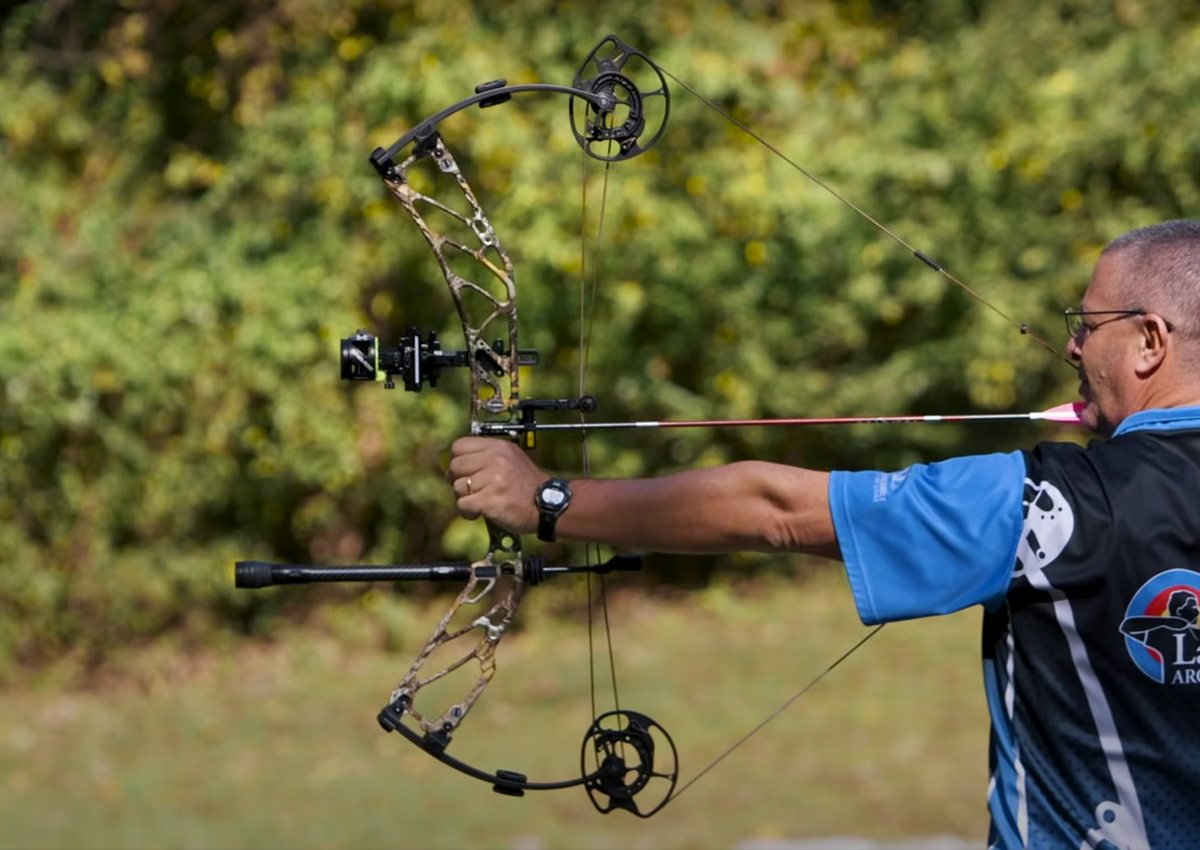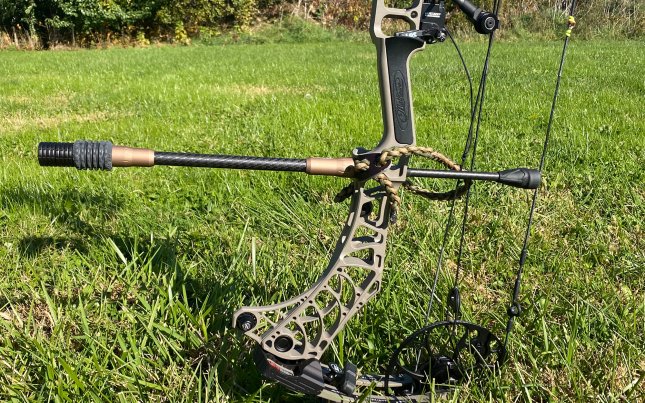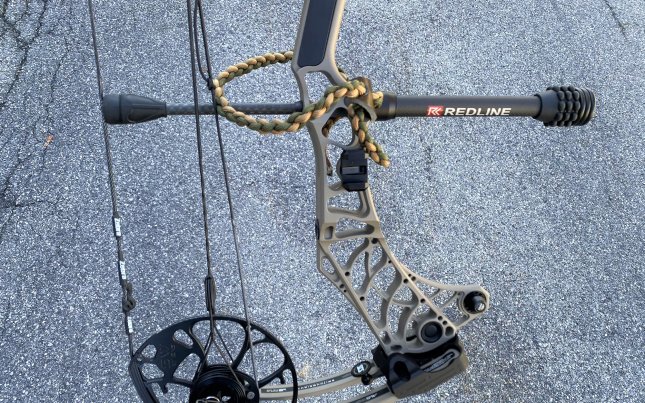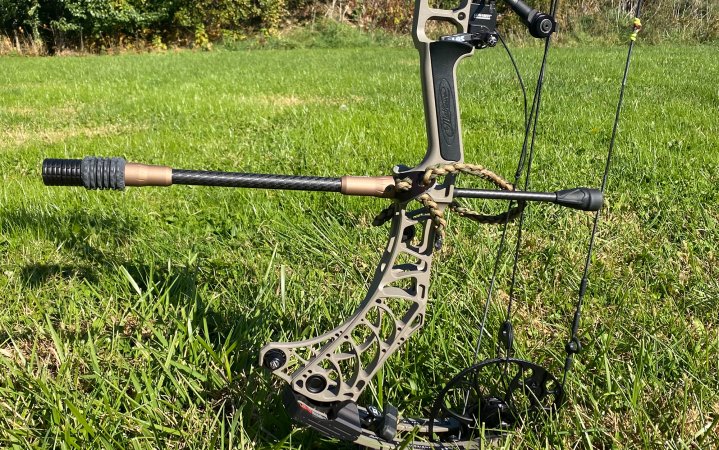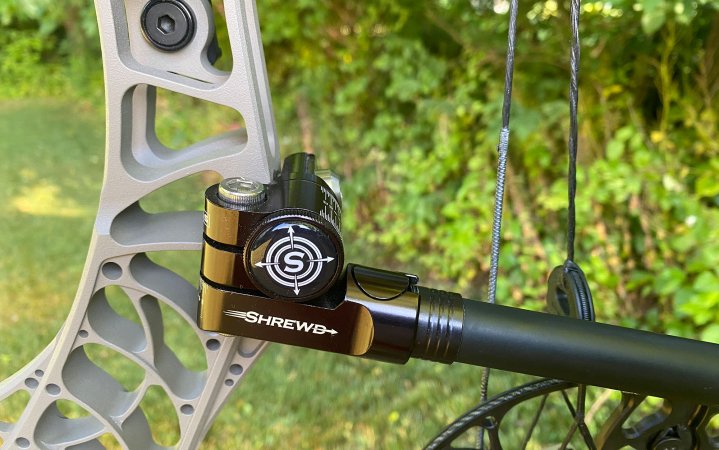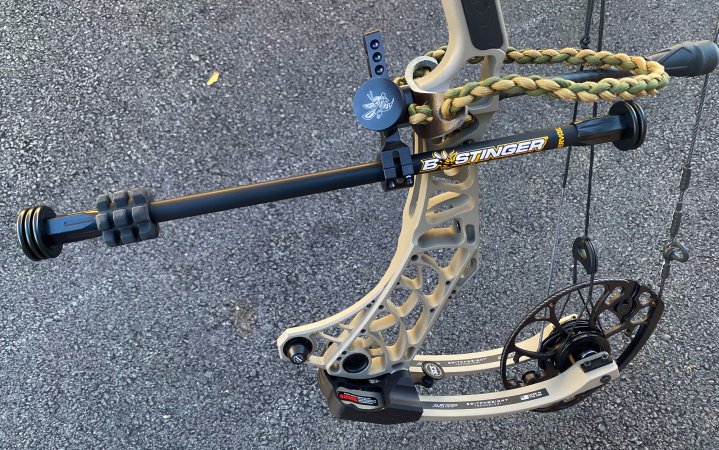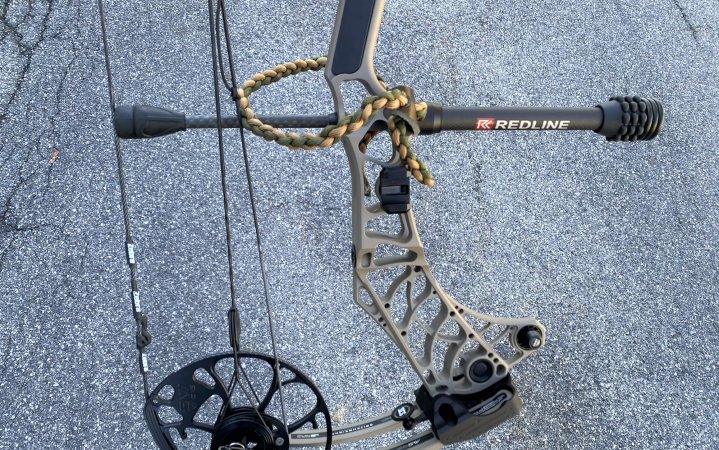We may earn revenue from the products available on this page and participate in affiliate programs. Learn More ›
Stabilizers are arguably the most misunderstood pieces of archery gear that bowhunters put on compound bows.
Target archers know how to use them to balance and stabilize their rigs. But bowhunters just seem to want something short and stubby, which results in almost none of the stabilizing benefits stabilizers are designed to produce.
Well, I’m here to tell you not only which stabilizers I’ve picked as my “best in class,” but I’m going to tell you what to look for in a stabilizer and how to use them properly.
At Lancaster Archery Supply, I get to see, feel and test most of the stabilizers on the market, so I have a pretty good idea of which ones lead the way. But just to confirm my picks for this piece, I tested nearly two dozen stabilizers by attaching them to my Mathews V3X 33 and shooting several arrows to feel for the stability, balance, and vibration reduction each bar produced. Here are my picks for the best bow stabilizers:
- Best Overall: Axcel Antler Ridge 10-inch
- Best Siderod Mount: Shrewd Atlas
- Best Combo Pack: Dead Center Dead Level Hunter Verge Lite Stabilizer Kit 12/9
- Best Single-Bar, Dual Purpose: Bee Stinger Microhex Counter Slide 15-Inch
- Best Budget: Redline Rl-1 8-Inch
- Best Short Bar: Shrewd Vantage 9-Inch
- Best Micro Diameter Hunting Rod: Conquest Control Freak With SMAC .500
- Best Stabilizer for a New Mathews Bow: 12-inch Mathews Bridge-Lock Stabilizer
Best Bow Stabilizers: Reviews & Recommendations
Best Overall: Axcel Antler Ridge 10-inch
Pros
- Is actually a tick under 12 inches when the dampener and both weights are included in the length
- Crushes vibration from every angle
- Promotes a steady hold at full draw
Cons
- Expensive
Key Features
- Made from high-modulus carbon and flax
- Kryptos Arc Dampener, which is designed to kill vibration on the X, Y, and Z axes
- Comes with two, 2-ounce weights
- Solid, aluminum end caps
A lot is going on in this 10-inch bar. It’s thin, it comes with 4 ounces of weight, the included dampener is one of the best on the market, and the bar is made from a unique mix of materials that do a great job of killing vibration while promoting rigid stabilization.
The Axcel Antler Ridge 10-inch hunting stabilizer is nearly 12 inches when both weights and the Kryptos Arc Dampener are added to the 10-inch bar. The bar is a combination of high-modulus carbon, which is super stiff, and flax, which is a natural fiber that acts like a vibration sponge. Its vibration-soaking properties are so well known that flax is used in all kinds of sporting gear, where reducing vibration is important, such as Formula 1. Axcel is the only company using flax in its stabilizers.

The Kryptos Arc Dampener would be an add-on for other stabilizers, but it comes with the Antler Ridge. Bow vibration at the shot is generated on the X, Y, and Z axes—horizontal, vertical, and depth. The Kryptos Arc is specially engineered to absorb vibration on each axis. Of all the stabilizers I tested, I felt the least amount of vibration in my hand with the Antler Ridge.
This is one of only a few bowhunting stabilizers that comes with 4 ounces of weights in the pack, which is a good amount for a 10-inch bar. Most hunting stabilizers come with 2 or 3 ounces of weights. You can usually add weights to any bar, but it’s nice when you don’t have to buy extra parts to make something work.

I picked a 10-inch bar as my best overall stabilizer because I believe it’s a length most bowhunters can work with. It’s definitely long enough to provide stabilization for any compound bow—especially since the total length of the Antler Ridge is basically 12 inches. (I discuss stabilizer length at the end of this article.) While I personally prefer a 15-inch front bar, I believe that’s a length a lot of bowhunters just won’t accept. And when I run a 15-inch front bar, I always have a side rod as part of my setup. The 10-inch Antler Ridge is perfect for having just the front rod and no side rod.
Best Siderod Mount: Shrewd Atlas
Pros
- Fits tight to the riser to minimize side bulk
- Doesn’t add much weight to an overall bow setup
- When the bolts are all tightened, everything is locked in place
- Weather resistant
Cons
- Sometimes the horizontal and vertical adjustments fit so snugly, you have to tap them with something to separate them so you can change the bar position.
Key Features
- Aluminum with stainless steel, anodized hardware to prevent rust
- Independent adjustments for horizontal and vertical positioning of the bar
- Tapered connection points so parts get tighter as the bolts are tightened
- Quick disconnect barrel included
- Laser-engraved connections allow user to get the bar in the same position time and again
- Weighs 3.8 ounces
The Shrewd Atlas is the perfect combination of what bowhunters look for in a siderod mount: strength, lightweight, and security. Made in the USA, the Atlas is CNC-machined aluminum with anodized stainless steel hardware. That means it’s not going to rust like other mounts do.

What’s missing from the Atlas is the bulk that seems to come with most siderod mounts. It weighs almost nothing—just 3.8 ounces—and fits tight to the riser. That means it won’t catch on branches and brush while you’re stalking or clang off the stand when you’re in the tree.
The Atlas employs tapered parts that essentially wedge together by bolts to lock them in place. The more you tighten a bolt, the more you drive a wedge into its seat, which makes it fit tighter. You want to position your siderod how you want it horizontally and vertically, lock it in place, and never think about it again. The Atlas does that.

Laser etching on the horizontal and vertical adjustments enables you to mark where the rod is positioned on each axis, so you can get it right back where you want it if you have to remove it from your bow, or move it from one bow to another. Once you find perfection with siderod position, you don’t want to have to hunt for it again.
Best Combo Pack: Dead Center Dead Level Hunter Verge Lite Stabilizer Kit 12/9
Pros
- Bars are super stiff
- Dampening qualities are good
- You get everything you need for a full setup in one pack
- The kit is less expensive than if you built a stabilizer/side rod setup by buying individual pieces
Cons
- A couple more weights for the side rod would have helped
- Even though it’s cost-effective, the sticker price will bulge some eyes
Key Features
- Includes a 12-inch bar, 9-inch siderod, connection mount, and 6 ounces of weights
- Verge dampener end caps
- Dampeners can be adjusted to sit perfectly vertical or horizontal, depending on preference for cutting wind
- The connection mount allows you to adjust the side rod up and down and left and right to position the weight where you want it
The Dead Center Dead Level Hunter Verge Lite Stabilizer Kit 12/9 is a one-stop package that has everything you need for a front-bar, side rod setup. It’s got a 12-inch bar for the front, a 9-inch bar for the side, and it’s got the mount you need to connect both bars to the bow, or just the side rod.
The bars are Dead Center’s best high-modulus carbon, so they are super stiff. The end caps are machined aluminum, which adds to the stability and rigidity of these bars. And each bar is topped with the Verge Dampener. It’s a ring of rubber surrounding a weighted centerpiece. At the shot, vibration hits the dampener, causing the weight to move around inside the rubber ring. That action soaks up the vibration, preventing most of it from getting to your hand. Set screws on the end of each rod allow you to position the dampeners perfectly vertical or horizontal once your bars are locked in place in the mount.

The mount can be used to attach both bars from the front, or you mount the front stabilizer by itself and then bolt the mount for the side rod to the back of the riser. If you mount both from the front, run the bolt on the long bar through the mounting bracket into the riser and then swivel the side rod connector to face backward.
The side rod connector pivots left and right and up and down so you can get the bar positioned precisely where you need it for the best balance. Once you lock it in place, it won’t budge. The two pieces you’re forcing together with the locking bolt are cone-shaped, so the more you drive in the bolt, the more you wedge those cones together. It’s super solid.
Six, 1-ounce weights are included in the kit for weighting and balancing the bars. I’d go 2 ounces out front and 4 ounces off the back, but you might find you need more to get the bow stable and balanced.
Best Single-Bar, Dual Purpose: Bee Stinger Microhex Counter Slide 15-Inch
Pros
- It’s one bar that does the job of two
- Can be adjusted multiple ways to get it to sit where you want it
- Countervail is one of the industry’s best materials for killing vibration
Cons
- It does a fair job of imitating having two bars, but it’s not the same
- Having five 1-ounce weights in the pack is nice, but you’ll most likely need to buy more to get the balance right between front and back
Key Features
- Single bar that can be adjusted forward and back to imitate having both a front stabilizer and a side rod
- Bar is 15 inches long, which allows for a decent amount of adjustment forward and back
- Proprietary Countervail material inside stabilizer helps kill vibration
- Dovetail mount makes bar removal and installation simple for travel
- Five 1-ounce weights included
The Bee Stinger Microhex Counter Slide is a thin, 15-inch bar that sits off the riser’s side, opposite your sight and quiver. Sitting there, the bar can offset the weight of those accessories.
From there, the unique mount allows you to slide the bar forward or back to adjust the distribution of weight. But it sort of mimics having a front stabilizer and a side rod. Given the length, you could adjust it so 8 inches stick out front and 7 inches extend backward. Then you add weights to each end to achieve the leverage you want. If the bow wants to tip forward, add more weight to the back, or slide the bar back. If it wants to tip up, add more weight to the front, or slide the bar forward.

The bar comes with the mount that connects it to the bow. It features a dovetail bar with a line of divots, which allows you to adjust how close to or far from the side of the riser the stabilizer sits. You can also pivot the riser mount up or down to pull the mount even closer to the riser if you want.
Bee Stinger’s Microhex bars are its narrowest, which makes them ideal for cutting through wind. And the Countervail material used inside the bars is very efficient at killing vibration. These bars transmit very little vibration back to the archer’s hand at the shot.
To be honest, I view dual-purpose bars like the Bee Stinger Microhex Counter Slide as a gateway stabilizer to a true front-rod/side rod setup. The Counter Slide does a fair job imitating the balancing effect of having two bars, but I believe it will convince you of the benefits of having both, and you’ll eventually pull the trigger on a two-bar rig.
Best Budget: Redline Rl-1 8-Inch
Pros
- Stiff carbon bar
- Quality dampener attacks vibration
- Three ounces of weights included
- Weight feels like it’s correctly placed for balance and vibration back to the shooter is minimal
- Costs under $60
Cons
- Vibrates a bit more than higher-end stabilizers
Key Features
- 8 inches
- Three, 1 ounce weights
- Rubber dampener
- Woven carbon bar
The Redline RL-1 8-inch stabilizer features a stiff carbon bar, a rubber dampener at the end of that bar, and three, 1-ounce weights. With the weights attached, the stabilizer is properly end-heavy. That is, the vast majority of the stabilizer’s overall weight is concentrated at the end. That’s especially critical when using a bar as short as 8 inches.
I chose an 8-inch bar for the “best budget stabilizer” because that’s the minimum length I believe stabilizers should be for most of today’s compound bows. (More on that at the end.) And the Redline RL-1 8-inch is the least expensive, 8-inch bar Lancaster Archery Supply carries.
But it’s not just a cheap stabilizer. It does its job. It helps the archer hold the bow steadier at full draw than without it, and it kills some vibration at the shot.
The Redline stabilizers do their job well, so much so, that we used the Redline RL Trio Back Bar and Stabilizer Kit to outfit bows during the 2023 compound bow test.
Best Short Bar: Shrewd Vantage 9-Inch
Pros
- Short, thin and light
- Special tapered interior promotes rigidity without adding weight
- Two Hi-Lo dampers helps squash vibration
- Long bolt allows many weights to be stacked to get the correct balance
Cons
- Only comes with two 1-ounce weights
Key Features
- 7, 9, or 12-inch lengths
- Includes two 1 ounce weights
- Two dampeners
Thin, light, lots of vibration dampening. For bowhunters concerned about having accessories stick out in front of their bows, the 9-inch Vantage is so slender and unassuming, it’s hard to argue that it’s “in the way.” Without any weights on it, the Vantage is incredibly light. Shrewd says that’s because of a unique tapered interior, which allows for a rigid, high-modulus carbon bar without any extra weight.

There are two Hi-Lo dampers on the Vantage. (Damper is a term often used to describe a rubber device designed to suppress vibration. It’s often used interchangeably with “dampener.”) The Hi-Lo dampers are designed to attack high-frequency and low-frequency vibration. Think of the difference as big, heavy vibration—low frequency—and smaller, lighter vibration—high frequency. A bow produces both, so Shrewd designed dampers to attack both. There’s no doubt the Vantage does a good job killing vibration with just 9 inches to its length.
The Vantage 9-inch comes with two, 1-ounce weights that are added to the stabilizer between the bar and the end Hi-Lo damper. This allows the end damper to serve as a rubber protection for the end of the stabilizer. The long bolt that connects the damper to the bar allows for many weights to be stacked, if you need them to get the right feel for your stabilizer.
But even with just the two ounces of included weight, the 9-inch Vantage does a good job helping stabilize the bow at full draw. The bar is so thin and so light it’s hard to imagine bowhunters fearful of stabilizers “getting in the way” thinking the Vantage is a cumbersome accessory.
Best Micro Diameter Hunting Rod: Conquest Control Freak With SMAC .500
Pros
- SMACWRAP is one of the best vibration-dampening materials on the market
- When a stabilizer is super light, you can use less weight on the ends for balance because you don’t have to offset the weight of a heavier bar
- The microdiameter rod cuts through the wind better than fatter rods
Cons
- If you care about such things, the graphics are a little odd
Key Features
- Carbon bar with aluminum end caps
- 1/2-inch diameter cuts through the wind
- Utilizes SMACWRAP, which is a proprietary material for vibration dampening
- Ultralight bar
- Includes three 1-ounce weights
The Conquest Control Freak With SMAC .500 is a half-inch wide stabilizer that’s built for performing in the wind. You won’t find a stabilizer thinner than a 1/2 inch on the market, so this hunting rod cuts through the wind the best. However, other 1/2-inch stabilizers employ weights significantly larger in diameter than the rod—especially if you use a big stack of weights. The Control Freak’s weights are only slightly larger than the rod, which minimizes wind drag.
Another benefit of skinny bars is they weigh less than fat ones. When a stabilizer bar weighs less, the effect of adding weights to the end is more noticeable. When you can feel the weights more, you can use less to achieve balance. And what bowhunter doesn’t prefer a light rig over a heavy one?
SMACWRAP is a proprietary material used in a variety of products for vibration dampening, including golf clubs. Conquest decided to put it inside some of its stabilizers, and it does a great job of killing vibration. Vibration in a bow does two things. It creates hand shock and noise. Noise, of course, is bad for bowhunting. And hand shock can make a bow unpleasant to shoot. Certainly, when you kill vibration, a bow is nicer to shoot, which will help you focus more on where the arrow should hit, rather than the hump your hand will feel.
The Control Freak With SMAC .500 comes in lengths of 6, 8, 10, 12, and 15 inches, and they can be used as front rods and as siderods.
Best Stabilizer for a New Mathews Bow: 12-inch Mathews Bridge-Lock Stabilizer
Pros
- The connection point is much more rigid than traditional stabilizers
- Adjustable length allows you to customize its fit
- Kills vibration and is super quiet
- InterLink Weight system eliminates the need for threaded rods
Cons
- Currently can only be used on Mathews Phase 4 bows
- Expensive
Key Features
- Mounts directly into Bridge-Lock risers, so the connection is more rigid
- Length is adjustable in half-inch increments
- Threadless, stackable weights
- Super skinny bar with holes throughout its length
- Harmonic dampener in the end cap
Mathews introduced the 12-inch Bridge-Lock Stabilizer in 2022 as a new stabilizer system for the Mathews Phase 4 bows. Presumably, this stabilizer will be usable in Mathews hunting bows in the future, as Bridge-Lock technology is incorporated into new offerings from Mathews. Despite the fact that it’s only good for two bows at present, it’s a solid, well-built stabilizer.
The bar is designed to slide into a Bridge-Lock receiver cut into the risers of the Mathews Phase 4 bows. It’s locked in place with a wing knob. Sliding the bar into the riser makes the connection point much more rigid than when a stabilizer gets screwed into a bushing under the grip.
Also, with this design, the 12-inch bar can be made shorter in 1/2-inch increments simply by pushing the bar deeper into the riser. So you can extend it to 12 inches for those long shots on the open prairie, or pull it in to 8 inches when it’s time to stalk through the thick stuff.
The bar is super skinny and has holes cut through its length. It imitates the geogrid design of the Mathews risers. So not only does the stabilizer match the bow, but those holes will allow wind to blow through it, making this stabilizer a great choice if you hunt in the wind.
For this stabilizer, Mathews developed a new weight system where weights can be linked together to create a weight stack held in place by an end cap secured with a single set screw. No threaded rods needed. And that end cap has a harmonic dampener built into it to soak up any vibration from the bow.
Things to Consider Before Buying the Best Bow Stabilizer

Why You Need a Stabilizer
A stabilizer is intended for two purposes—to help you hold a bow steady and to help kill vibration at the shot. A stabilizer helps you hold a bow steady by adding weight to the bow below your hand, and by resisting hand torque. A great, albeit exaggerated, example of how it resists torque is to think about holding a dust brush and a full-length broom out in front of you with your arm extended. It’s easy to move the dust brush side to side because it’s short and it’s light. But the broom is going to resist that sideways motion because of its length and the heft at the very end.
Stabilizer Length
Again, that’s an exaggerated example of what a stabilizer does, but it paints a general picture of the principle. And it demonstrates why target archers typically use 28 to 36-inch front stabilizers that can carry more than 25 ounces at the very end. Bowhunters don’t need to go that far. Such a stabilizer would be cumbersome in the woods.
But what bowhunters need to know is that a “stabilizer” offers no stabilization at all until it extends beyond the limb pockets. And with the way many of the best compound bow risers today are reflexed back toward the archer, the stabilizer bushing might sit 4 or 5 inches behind those pockets. That means you don’t get any stabilization at all from a stabilizer 6 inches or less.
On most bows, an 8-inch stabilizer would be the minimum length needed for a stabilizer to be fully functional. Ten- and 12-inch bars would be even better. Whenever I encounter a bowhunter who balks at the thought of a 12-inch stabilizer because it “sticks out too far,” I have them nock an arrow. No 12-inch stabilizer sticks out as far as a 27-30-inch arrow. The point being, if you think a 10-inch stabilizer is going to get in the way at some point during a hunt, your arrow will be an even bigger problem.
Weights
The good news is that the longer the bar, the less weight you need on that bar. On my setup, I only have 3 ounces on the end of my 15-inch stabilizer. If I went to an 8-inch bar, I’d have to bump that weight up to about 10-12 ounces in search of comparable stability.
Side Rods
However, as the front stabilizer gets longer, the need for a sideroad increases to balance the bow. A long front bar with even just a little weight at the end will cause a bow to want to tip forward. A side rod adds weight behind the bow to counteract that forward tipping. Twelve inches with just a couple ounces of weight at the end is about as long and heavy as I’d go with a front bar before adding a side rod.
FAQs
A stabilizer is an individual tool. It’s meant to help each archer depending on their abilities and needs. Most bowhunters don’t know what a good stabilizer setup can do for them because they don’t experiment with different lengths and weights. I get it. Who has the time and/or money to get a bunch of stabilizers and shoot them in different configurations?
If you can, get to an archery pro shop that will allow you to experiment with equipment on their range. Shoot with friends who have different stabilizer setups and swap bars. Or shop online for used equipment to eventually amass a selection of stabilizers over time.
A longer stabilizer provides more leverage, and many target archers use stabilizers from 28 to 33 inches. The minimum stabilizer length should be 2 inches longer than the gap between the riser and the outside edge of the limb pockets. On my Mathews V3X 33, that’s an 8-inch minimum length. Any shorter than that, and you’re only killing vibration.
This is a complex question, but the simple answer is, u0022no, you don’t need a side rod to shoot a bow accurately.u0022 A side rod can help. It can help you hold a bow steadier than you ever have in your life. Every top end target archer I can think of who also bowhunts runs a front stabilizer and side rod on their hunting rigs. And these are archers who have the greatest ability to justify not using a side rod. But they do. Obviously, they see a benefit. I do too—especially when shooting long range. Can you consistently make the shots you need to make to be an effective bowhunter without one? That’s your call.
There are short, rubber vibration dampeners that you can mount in the stabilizer bushings on bows that cost as little as $15. But as I mentioned, those aren’t stabilizers. For true stabilizers, you’re looking at anywhere from about $30 up to $180 for single bars. Combination front bars and side rods, of course, will push that top price higher.
Final Thoughts
When used correctly, the best bow stabilizers can make a decent archer a decent and consistent archer. They’ll help you hold steady and feel comfortable at the shot. When you’re comfortable, you’re relaxed. When you’re relaxed, you can drive tacks. Don’t just think of stabilizers as something to put in the bushing under the grip. They’re designed for a purpose. Take the time to figure out how they can make you a better archer.
